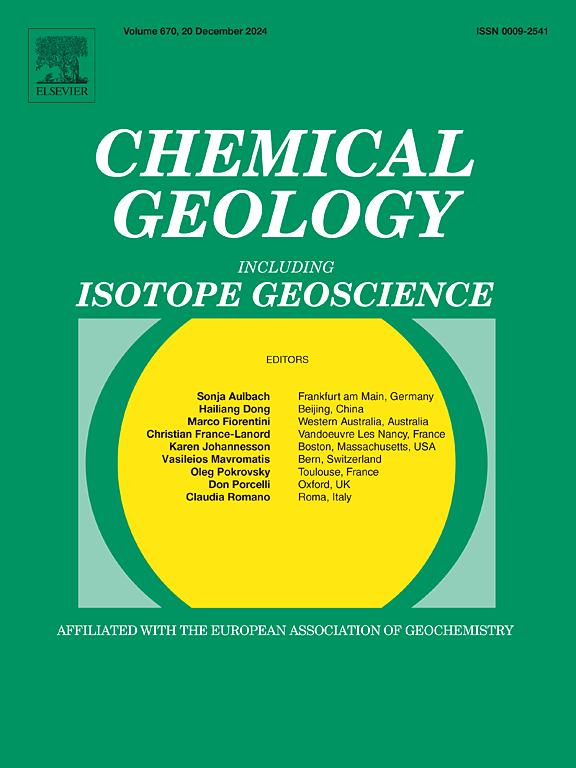石炭系旋回演替的盐度变化
IF 3.6
2区 地球科学
Q1 GEOCHEMISTRY & GEOPHYSICS
引用次数: 0
摘要
北美克拉通的晚古生代海域因冈瓦纳冰蚀作用而在海拔和海相方面发生了巨大的波动,但盐度变化的量化却很困难。在这里,我们使用两种代用指标(B/Ga 和 "过量硼"[Bxs])重建了宾夕法尼亚中大陆架晚期一个岩芯中横跨上德莫尼期到密苏里期(308-303 Ma)的十个旋回的盐度变化。这些代用指标记录了正常海相(30-40 psu)和高咸水条件(15-30 psu)之间的周期性变化,偶尔也会出现低咸水条件(1-15 psu)的偏移。大多数石灰岩层都是在海洋盐度条件下堆积的,但也有少数石灰岩层(如含芒刺的埃克斯莱恩石灰岩和雷敦石灰岩)是含咸的。页岩的盐度变化范围更大:富含有机质的岩心页岩与完全的海洋条件有关,而外部页岩大多与盐度降低的条件有关。研究岩芯的岩性和盐度历史为了解宾夕法尼亚中晚期过渡时期的同期构造-冰川事件提供了线索:波尼-阿尔塔蒙特旋回记录了一次重大的基底下沉事件,随后诺瓦塔页岩的三角洲硅质碎屑岩大规模涌入,与瓦奇塔-马拉松造山带最新的德莫尼期隆起有关。这一北美构造事件,加上全球其他同时发生的造山运动,可能引发了在德莫尼期/密苏里期边界附近冰川驱动的海平面深度下降。这一事件预示着密苏里期大振幅、高频率冰川-静电波动的开始,标志着冈瓦纳冰盖不稳定性加剧的根本性转变。本文章由计算机程序翻译,如有差异,请以英文原文为准。
Salinity variation in Carboniferous cyclothemic successions
Late Paleozoic seas on the North American Craton were subject to large fluctuations in elevation and facies in response to Gondwanan glacio-eustasy, but quantification of salinity variation has proven difficult. Here, we reconstruct salinity variation using two proxies (B/Ga and “excess boron” [Bxs]) through ten cyclothems spanning the upper Desmoinesian through Missourian stages (∼308–303 Ma) in a single core from the Late Pennsylvanian Midcontinent Shelf. These proxies record cyclic variation between normal-marine (30–40 psu) and high-brackish conditions (15–30 psu), with occasional excursions to low-brackish conditions (1–15 psu). Most limestone formations accumulated under marine salinity conditions although a few (i.e., the argillaceous Exline and Raytown limestones) were brackish. Shales exhibit a wider range of salinity variation: organic-rich core shales are associated with fully marine conditions and outside shales mostly with reduced-salinity conditions. The lithofacies and salinity history of the study core provide insights into contemporaneous tectono-glacial events of the Middle to Late Pennsylvanian transition: the Pawnee-Altamont cyclothems record a major basinal subsidence event followed by large-scale influx of deltaic siliciclastics of the Nowata Shale linked to latest Desmoinesian uplift in the Ouachita-Marathon orogens. This North American tectonic event, coupled with other concurrent orogens globally, may have triggered a deep glacially driven sea-level fall around the Desmoinesian/Missourian stage boundary. This event heralded the onset of large-amplitude, high-frequency glacio-eustatic fluctuations of the Missourian Stage, signaling a fundamental shift toward increased Gondwanan icesheet instability.
求助全文
通过发布文献求助,成功后即可免费获取论文全文。
去求助
来源期刊

Chemical Geology
地学-地球化学与地球物理
CiteScore
7.20
自引率
10.30%
发文量
374
审稿时长
3.6 months
期刊介绍:
Chemical Geology is an international journal that publishes original research papers on isotopic and elemental geochemistry, geochronology and cosmochemistry.
The Journal focuses on chemical processes in igneous, metamorphic, and sedimentary petrology, low- and high-temperature aqueous solutions, biogeochemistry, the environment and cosmochemistry.
Papers that are field, experimentally, or computationally based are appropriate if they are of broad international interest. The Journal generally does not publish papers that are primarily of regional or local interest, or which are primarily focused on remediation and applied geochemistry.
The Journal also welcomes innovative papers dealing with significant analytical advances that are of wide interest in the community and extend significantly beyond the scope of what would be included in the methods section of a standard research paper.
 求助内容:
求助内容: 应助结果提醒方式:
应助结果提醒方式:


